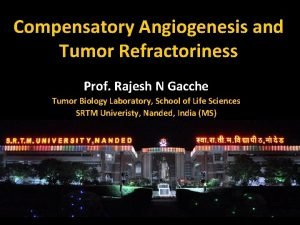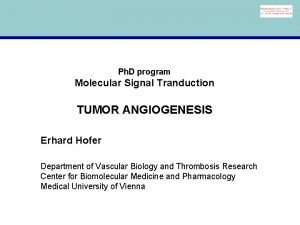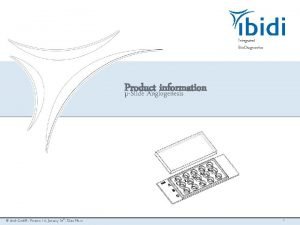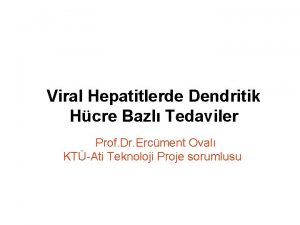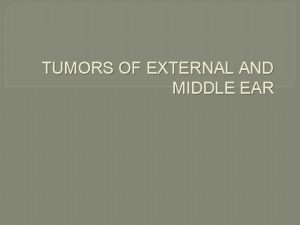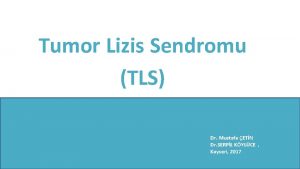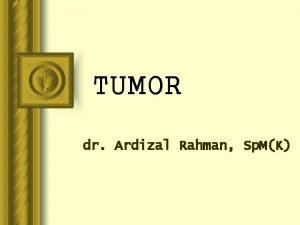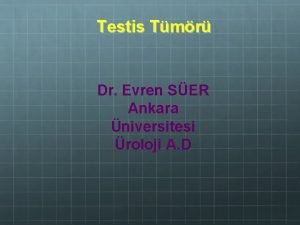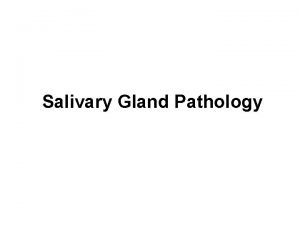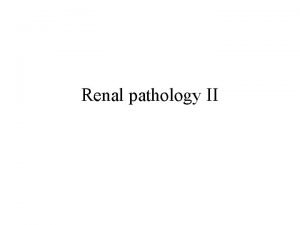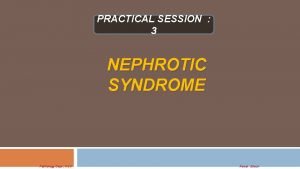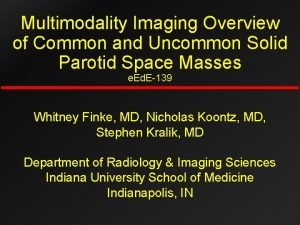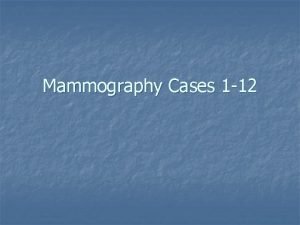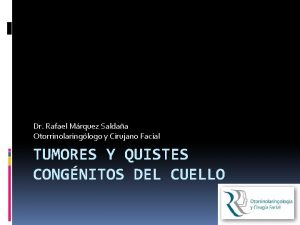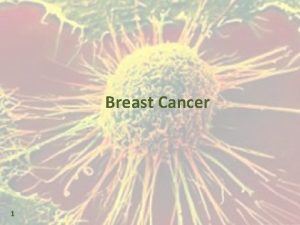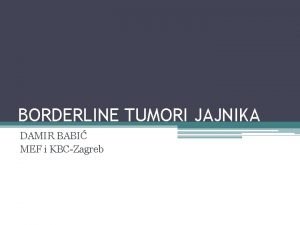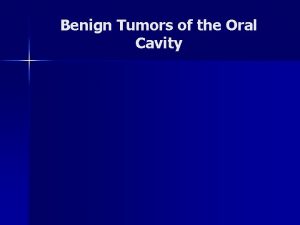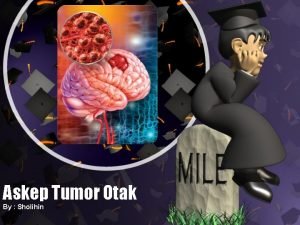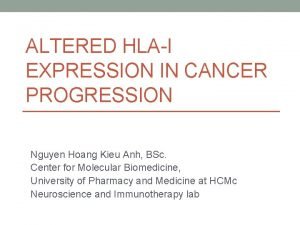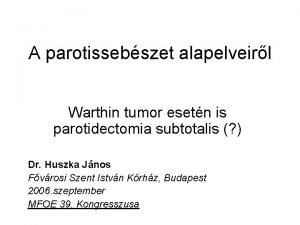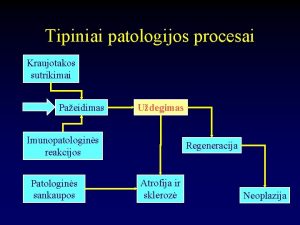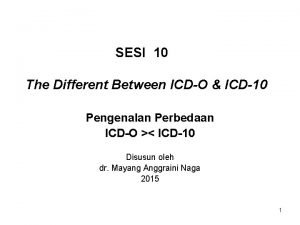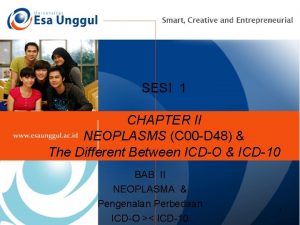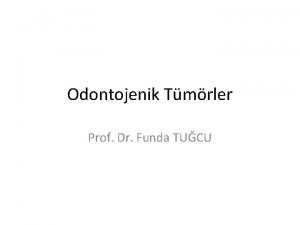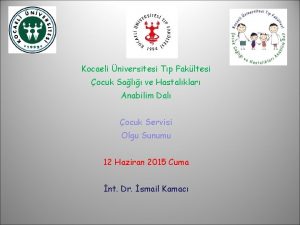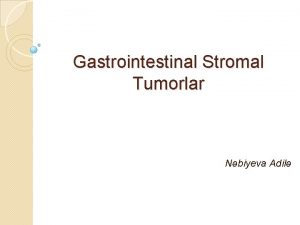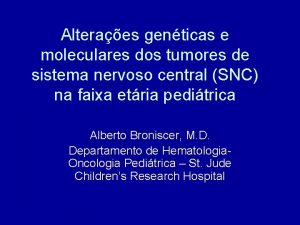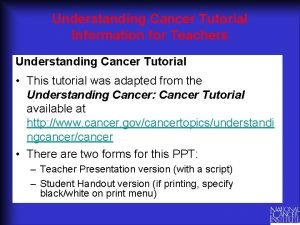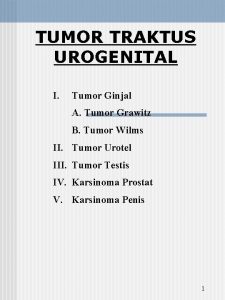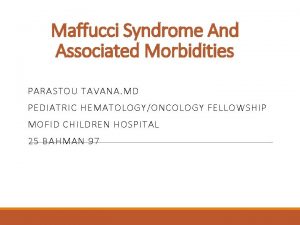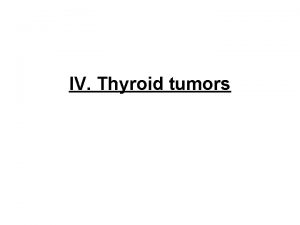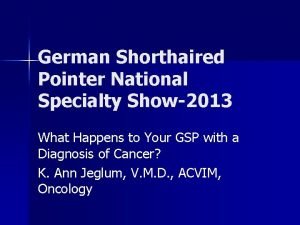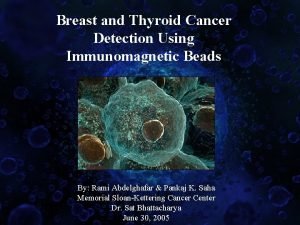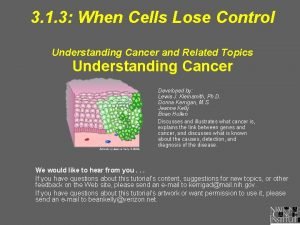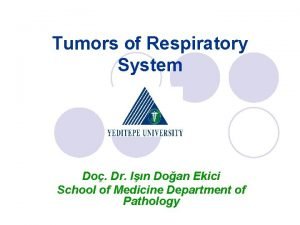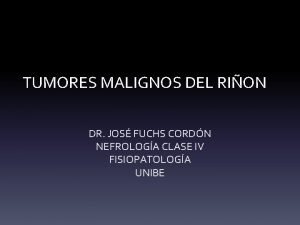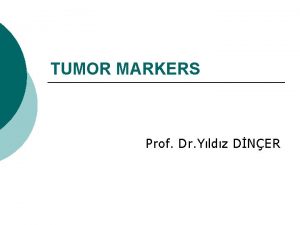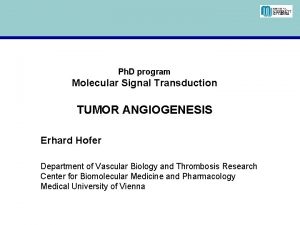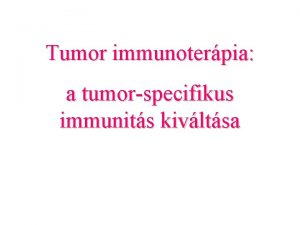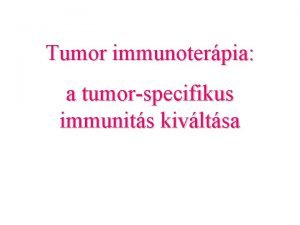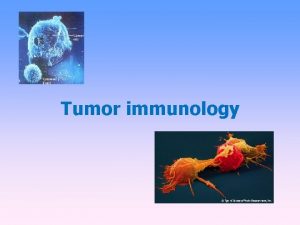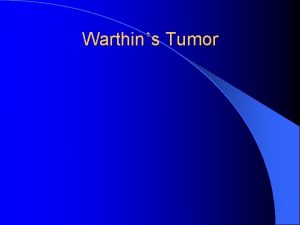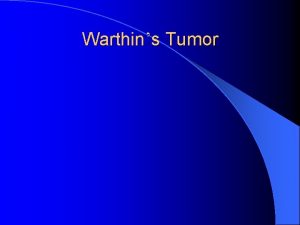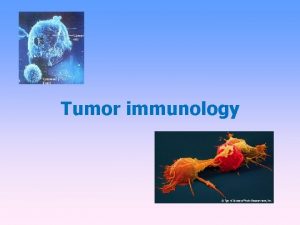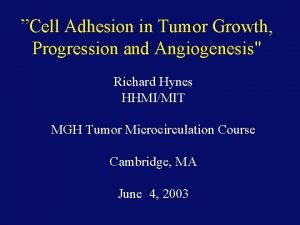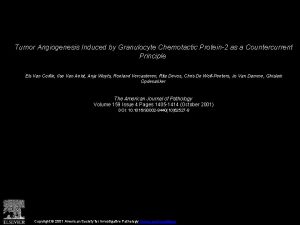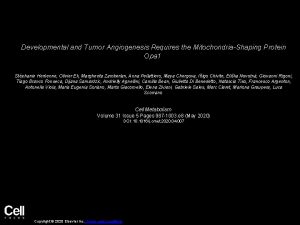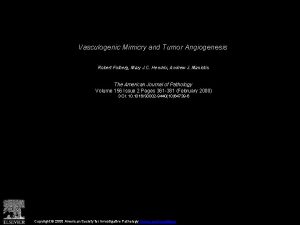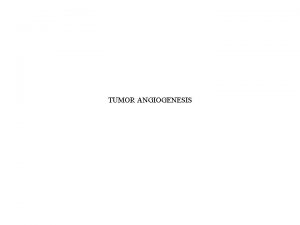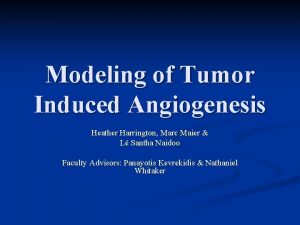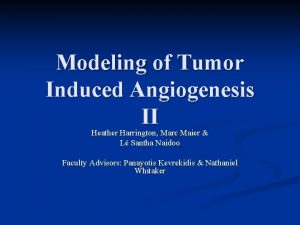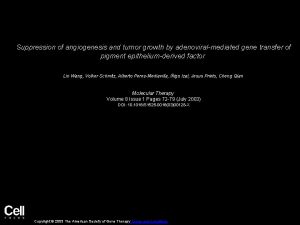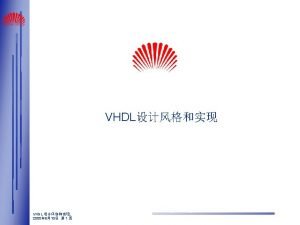Ph D program Molecular Signal Tranduction TUMOR ANGIOGENESIS



















































- Slides: 51

Ph. D program Molecular Signal Tranduction TUMOR ANGIOGENESIS Erhard Hofer Department of Vascular Biology and Thrombosis Research Center for Biomolecular Medicine and Pharmacology Medical University of Vienna

Part I: Overview of vessel formation 1 - Angiogenesis and vasculogenesis 2 - Important factors and receptors 3 - VEGF receptor signaling 4 - Tumor angiogenesis 5 - Anti-angiogenesis therapies

Literature: Books: B. Alberts et al. , Molecular Biology of the Cell, 5 th Edition, Taylor and Francis Inc. , 2007 Pg. 1279 -1283 R. A. Weinberg, The Biology of Cancer, Garland Science, 2007 Pg. 556 -585 Tumor Angiogenesis - Basic mechanisms and Cancer Therapy, D. Marme, N. Fusenig, ed. Springer Verlag 2008 Angiogenesis - From basic science to clinical application N. Ferrara, ed. CRC Press, Taylor&Francis Group, 2007

Literature: Reviews: Nature Insight Angiogenesis G. D. Yancopoulos et al. (2000). Vascular-specific growth factors and blood vessel formation. Nature 407, 242 -248. Angiogenesis Focus, Nature Med 9, June 2003 Peter Carmeliet, Angiogenesis in Health and Disease Napoleone Ferrara et al. , The biology of VEGF and its receptors Rakesh K. Jain, Molecular regulation of vessel maturation Shanin Rafii and David Lyden, Therapeutic stem and progenitor cell transplantation for organ vascularization and regeneration Christopher W. Pugh and Peter J. Ratcliffe, Regulation of angiogenesis by hypoxia: role of the HIF system Angiogenesis, Nature Reviews Cancer 3, June 2003 Gabriele Bergers and Laura E. Benjamin, Tumorigenesis and the angiogenic switch

C. J. Schofield and P. J. Ratcliffe. Oxygen sensing by HIF hydroxylases. Nature Rev. Mol. Cell Biol. 5, 343 -354 (2004) Nature Insight Angiogenesis, Vol. 438, pg. 931 -974, December 2005 Carmeliet, Angiogenesis in life, disease and medicine Coultas, Endothelial cells and VEGF in vascular development Alitalo, Lymphangiogenesis in development and human disease Greenberg, From angiogenesis to neuropathology Gariano, Retinal angiogenesis in development and disease Ferrara, Angiogenesis as a therapeutic target P. Carmeliet and M. Tessier-Lavigne, Common mechanisms of nerve and blood vessel wiring, Nature 436, 195 -200 (2005) J. Folkman, Angiogenesis: an organizing principle for drug discovery ? Nature Reviews Drug Discovery 6, 273 -286 (2007)

Role of notch: Adams and Alitalo, Molecular regulation of angiogenesis and lymphangiogenesis, Nature Rev Mol Cell Biol 8, 464 -478 (2007) Germain et al. , Hypoxia-driven angiogenesis, Curr Opinion in Hematol 17 (2010) Guidance cues: Larrivee et al. , Guidance of vascular development: Lessons from the nervous system, Circulation Research 104, 428 -441 (2009) Gaur et al. , Role of class 3 semaphorins and their receptors in tumor growth and angiogenesis, Clin Cancer Res 15, 6763 -70 (2009)

www. mailbox. univie. ac. at/erhard. hofer http: //mailbox. univie. ac. at/erhard. hofer Student point, Vorlesungsunterlagen erhard. hofer@univie. ac. at

Structure of vessels and capillaries Small artery: Monocellular layer of endothelial cells Capillary: endothelial cell, basal lamina, pericytes

Angiogenesis: Sprouting of cells from mature endothelial cells of the vessel wall (secretion of proteases, resolution of Basal lamina, migration towards Chemotactic gradient, proliferation, Tube formation) VEGF is factor largely specific for endothelial cells, b. FGF can also induce, not specific for EC) Mouse cornea: wounding induces angiogenesis, chemotactic response to angiogenic factors

Sprouting towards chemotactic gradient: VEGF

Hypoxia - HIF - VEGF every cell must be within 50 to 100 mm of a capillary HIF: hypoxia inducible factor VEGF: vascular endothelial growth factor

Von Hippel-Lindau Tumor Suppressor, HIF and VEGF-gene: Regulated by HIF, HIF is continously produced, ubiquitinylated, degraded in proteasome, therefore low concentration; Ubiquitinylation dependent on Hippel-Lindau tumor suppressor (part of an E 3 ubiquitin-ligase complex) HIF 1 is modified by a prolyl hydroxylase, then better interaction with v. HL protein, high turnover; Hydroxylase is regulated by O 2

capillaries sprouting in the retina of an embryonic mouse

capillary lumen opening up behind the tip cell (red dye injected)

Vasculogenesis Formation of vessels by differentiation of cells from angioblasts in the yolk sac of the embryo: Is differentiation and proliferation of endothelial cells in a non-vascularized tissue Leads to formation of a primitive tubular network Has to undergo angiogenic remodeling to stable vascular system

Postnatal vasculogenesis Hemangioblast Angioblast EC

Factors and receptors Endothelium-specific factors: VEGF family: 5 factors Angiopoietin family : 4 factors Ephrin family : at least 1 factor Non EC-specific factors : b. FGF PDGF TGF-

VEGF/VEGFR family VEGF/VEGFR: VEGF-A: initiation of vasculogenesis and sprouting angiogenesis, Immature vessels, Vascular permeability factor, Haploid insufficiency in k. o. mice, Pl. GF: remodeling of adult vessels VEGF-B: heart vascularization ? VEGF-C: lymphatic vessels VEGF-D: lymphatic vessels ? VEGFR-2: growth and permeability VEGFR-1: negative role ? , decoy receptor, synergism with VEGFR-2 in tumor angiogenesis VEGFR-3: lymphatic vessels

Network of lymphatic vessels (red) and capillaries (green): Lymphatic vessels are larger, not supported by underlying mural cells Figure 13. 31 The Biology of Cancer (© Garland Science 2007)

Differential signaling by tyr kinase receptors EC “specific” factors/receptors: VEGFR 2 VEGFR 1 VEGF-A, PLGF VEGFR 2 VEGF-A VEGFR 3 TIE 1 TIE 2 VEGF-C ? ANG 1, 2 Y 799 Y 820 P 38, src (vascular leakage? ) Y 925 Y 936 Y 951 TSAd (migration) Y 994 Y 1006 Y 1052 Y 1057 PI-3 kinase (survival) Y 1080 Y 1104 gene regulation Y 1128 Y 1134 Y 1175 Y 1212 Y 1221 Y 1303 Y 1307 Y 1317 PLC- proliferation vasculogenesis angiogenesis Sakurai et al. PNAS 2005

82 of the most strongly VEGF-regulated genes (over 5 -fold) compared to EGF and IL-1 induction VEGF + IL-1 cluster VEGF + EGF cluster VEGF cluster

Overlapping and specific gene repertoires of VEGF, EGF and IL-1 VEGF 20% 60% IL-1 About 60 genes reproducibly induced by VEGF over 3 -fold VEGF-induced genes overlap to a large degree with IL 1 -induced genes (50 -60 %) 20 % of genes are preferentially induced by VEGF

Signaling by receptors of endothelial cells IL-1 VEGF-A IL-1 R EGF VEGFR-2 EGFR p 38 P PLC- My. D 88 951 Ts. Ad P P 1175 PI 3 K IKK /IKK Ca++ P Grb 2 Actin cytoskeleton PKC Ras Akt I B NF B Calcineurin NFAT EGR-1 gene regulation proliferation inflammation Raf MEK/ERK survival migration permeability angiogenesis Hofer E. , Schweighofer B. Signaling transduction induced in endothelial cells by growth factor receptors involved in angiogenesis. Thrombosis ang haemostasis 2007

Guidance molecules in endothelial tip cell attraction and repulsion Carmeliet P, Nature. 2005 Eichmann A, Curr Opin Neurobiol. 2005

Angiopoietins und Tie Receptors: Ang 1: remodeling and maturation Quiescence and stability Resistance to permeability, Supports interaction with other cells and matrix, Vessel size (VEGF number of vessels), Repair of damaged vessels Ang 2: natural antagonist, Overexpression similar Ang-1 k. o. oder Tie-2 k. o. , Destabilization signal for initiation of vascular remodeling Either regression or increased VEGF sensitivity Ang 2 is induced in tumors Ang 3: ? Ang 4: ? Tie 2: binds Ang 1 -4 Tie 1: ?

Ephrins und Eph-Receptors: Largest family of growth factor receptors, Relevant for vascular system: Ephrin B 2/ Eph B 4 : remodeling and maturation Different for early arterial (Ephrin B 2) and venous vessels (Eph. B 4), Hypothesis: role for fusion of arterial/ venous vessels






Growth of tumor vessels 3 -incorporation of BM-derived precursors 2 -Intussusceptive growth 1 -Sprouting 4 -Cooption of existing vessels 5 -Lymphangiogenesis

Role of VEGF and Ang 2 for tumor angiogenesis, VEGF-blockade is promising for anti-ngiogenesis therapy Concept 1: non-vascularized Tumor Concept 2: many tumors “home in” onto vessels, occupate existing vessels, Vessel produces Ang 2, first tumor regression, then VEGF production by tumor

Recruitment of capillaries by an implanted tumor Figure 13. 32 a The Biology of Cancer (© Garland Science 2007)

Chaotic organization of tumor-associated vasculature Figure 13. 34 a The Biology of Cancer (© Garland Science 2007)

Structure and function of tumor vessels: Chaotic architecture and blood flow Therefore hypoxic and acidic regions in tumor Permeability strongly increased fenestrae enlarged Junctions No functional lymphatics inside the tumor enlarged in surrounding, increases metastasis

Mosaic vessels

Abnormale endothelium

Tumor vessel is only partially overlaid by pericytes and SMC Figure 13. 33 The Biology of Cancer (© Garland Science 2007)

The Rip-Tag model of islet tumor cell progression Transgene: SV 40 large and small T transcription driven by insulin promoter Transcription in b-cells of islets of Langerhans Figure 13. 37 The Biology of Cancer (© Garland Science 2007)

The angiogenic switch and recruitment of inflammatory cells Figure 13. 38 b The Biology of Cancer (© Garland Science 2007)


Heterotypic interactions as targets for therapeutic intervention Figure 13. 49 The Biology of Cancer (© Garland Science 2007)

Inhibition of tumor angiogenesis (Combination with 5 -fluorouracil for colorectal cancer) 1 -Bevacizumab 2 -VEGF-trap 3 -Pegaptinib (Macular degeneration) 4 6 - downstream Signals ? 5 - SU 11248 Bay 43 -9006




Bevacizumab Colorectal cancer Phase III Combination therapy Hurwitz et al. 2004 Mass et al. 2004 IFL: Irinotecan 5 -fluorouracil Leucovorin Median survival benefit of two trials (2004): 3. 7 -4. 7 months


Gentherapien: r. Adenoviren r. Retroviren Targeting of viruses to tumors, tumor endothelium Targeting of liposomes to tumors, tumor endothelium Oncolytic viruses BM progenitor cells home to tumor vasculature

Next meeting in Zürich, June 15 -18, 2011 organized by Michael Detmar, ETH
 Tumor angiogenesis
Tumor angiogenesis Sprouting and intussusceptive angiogenesis
Sprouting and intussusceptive angiogenesis Ibidi free sample
Ibidi free sample Physical state of covalent compounds
Physical state of covalent compounds Ionic covalent metallic
Ionic covalent metallic Giant molecular structure vs simple molecular structure
Giant molecular structure vs simple molecular structure Baseband signal and bandpass signal
Baseband signal and bandpass signal Baseband signal and bandpass signal
Baseband signal and bandpass signal Digital signal as a composite analog signal
Digital signal as a composite analog signal Even odd signals
Even odd signals Dendritik hücre aşıları
Dendritik hücre aşıları Rising sun sign ent
Rising sun sign ent Bishop sınıflaması
Bishop sınıflaması Koristoma adalah
Koristoma adalah Intratübüler germ hücre neoplazisi
Intratübüler germ hücre neoplazisi Monomorphic adenoma salivary gland
Monomorphic adenoma salivary gland Grawitz tumor
Grawitz tumor Tumor pathology
Tumor pathology Cryoablation fibroadenoma
Cryoablation fibroadenoma Warthin's tumor ultrasound images
Warthin's tumor ultrasound images Phyllodes tumor mammogram
Phyllodes tumor mammogram Tumor treating fields mechanism of action
Tumor treating fields mechanism of action Anomalias
Anomalias Tumor twins 7 habits
Tumor twins 7 habits How big is a 5 cm tumor
How big is a 5 cm tumor Borderline tumor jajnika
Borderline tumor jajnika Benign tumor definition
Benign tumor definition Kti tumor otak
Kti tumor otak Dormant tumor
Dormant tumor Warthin tumor kezelése
Warthin tumor kezelése Rubor tumor calor dolor
Rubor tumor calor dolor Kode icd 10 tumor supraclavicular
Kode icd 10 tumor supraclavicular Kode icd 10 oat
Kode icd 10 oat Neoformacion
Neoformacion Odontojenik tümör sınıflaması
Odontojenik tümör sınıflaması Osteosarkom
Osteosarkom Disembriyoplastik nöroepitelyal tümör
Disembriyoplastik nöroepitelyal tümör Fibrosarcoma gross
Fibrosarcoma gross Tumor teratóide rabdóide atípico
Tumor teratóide rabdóide atípico Tumor suppressor genes
Tumor suppressor genes Tumor vasoproliferativo
Tumor vasoproliferativo Trias tumor ginjal
Trias tumor ginjal Call exner bodies
Call exner bodies Follicular adenoma
Follicular adenoma Mast cell tumor german shorthaired pointer
Mast cell tumor german shorthaired pointer Tumor detection
Tumor detection Cancer prefix
Cancer prefix Hipertrofia adenoidea tratamiento
Hipertrofia adenoidea tratamiento Pancoast tumor
Pancoast tumor Causas de deshidratación
Causas de deshidratación Esofago
Esofago Penanda tumor ca 19-9
Penanda tumor ca 19-9
